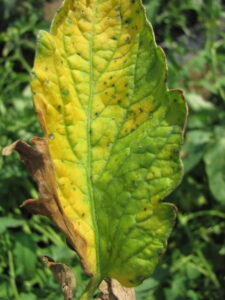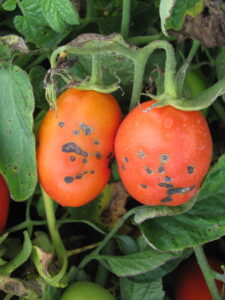In the Midwest, three major bacterial diseases threaten tomato production. These diseases are bacterial canker, bacterial spot and bacterial speck. Although these diseases are all caused by bacteria, they vary in symptomology, biology and management options. In the last issue of the Vegetable Crops Hotline, we discussed bacterial canker. In this second in the series, we will discuss bacterial spot.
Bacterial spot causes lesions on all foliar portions of tomato plants. Leaf spots are usually circular, 1/16 inch, and dark. Where lesions are numerous upon a leaf, the tissue may be chlorotic (yellow) (Figure 1). (In contrast, each lesion of bacterial speck is often accompanied by chlorosis whether lesions are numerous or not.) Lesions of bacterial spot on fruit are dark, raised and up to 1/3 inch in diameter (Figure 2). The disease prefers warm, wet weather. Overhead irrigation will also spread this disease.

Figure 1: Lesions of bacterial spot of tomato may be associated with yellowing when many lesions occur close together.
Bacterial spot is much more common in field tomatoes than in greenhouse or high tunnel tomatoes. This is because bacterial spot requires leaf wetness for infection to take place and rain to spread the bacteria from leaf to leaf and from plant to plant. For the most part, tomato plants under cover lack sufficient leaf wetness to allow bacterial spot to become a problem. The bacterial pathogen that causes bacterial spot does not become systemic such as with bacterial canker. This helps explain why bacterial spot is not a factor in greenhouse production. However, bacterial spot can be a factor in the transplant greenhouse since such plants are watered overhead. Once a tomato plant with bacterial spot is moved to a greenhouse where it is watered via drip, the lesions can’t move from the original lesions and since the disease is not systemic, it won’t move within the plant.
You may have heard about bacterial spot of pepper and pumpkin. Bacterial spot of pepper is closely related and may be able to go to tomato. Bacterial spot of pumpkin is related but will not affect pepper or tomato.
Successful management of bacterial spot requires a combination of cultural and pesticide treatments. Since bacterial spot may be seed borne; the disease may have been brought in on your seed/transplants. However, the causal bacterium also survives on crop residue. Tomatoes should be rotated 2 to 3 years away from peppers or tomatoes. Treatment with copper hydroxide may reduce spread in the field. Some strains of the bacterial spot pathogen are resistant to copper products. In a recent Purdue University study in 2016 and 2017, 84% of bacterial spot strains collected were copper insensitive (resistant). To increase the amount of copper available on the leaf, copper products may be mixed with fungicides with the active ingredient mancozeb (e.g., Dithane®, Manzate®, Penncozeb®). Many copper products may be used in some organic schemes.
Streptomycin products are labeled for use on tomatoes only in the transplant greenhouse (e.g., Agri-mycin®, Harbour®). The survey mentioned above found that 58% of bacterial spot strains were insensitive to streptomycin. So, it makes sense to treat with a streptomycin in the transplant greenhouse before going to the field.
Products with the active ingredient hydrogen dioxide (e.g., Oxidate®) are also labeled for bacterial spot in the field and greenhouse. Hydrogen dioxide can kill bacteria on contact, however, it has very little to no residual. In general, I do not recommend the application of hydrogen dioxide products in the field for control of bacterial spot. The use of Oxidate® in the greenhouse makes more sense since the product can be easily applied multiple times. Do not substitute hydrogen dioxide for copper, streptomycin or Actigard®. Be careful when mixing Oxidate® with other products. When used with copper products, for example, Oxidate® may not mix well. Read the labels of all the products carefully. Oxidate® may be used in some organic schemes.
Another product that has been used for management of bacterial spot of tomato is acibenzolar-S-methyl (trade name Actigard®). Acibenzolar (ASM) is known as a systemic acquired resistance product. That is, it ‘tells’ the plant to turn on biochemical pathways that defend the plant from infection. ASM has been used with copper products to lessen the severity of bacterial spot of tomato. However, ASM can cause yield loss if used on tomatoes that are stressed due to drought or other environmental factors.
Serenade Opti® (an older name for this product is Serenade Max®) is labeled for bacterial spot of tomato. Serenade Opti® may be used in some organic schemes.
A similar microbial product is called LifeGard®. The mode of action is similar to Actigard® and to Serenade Opti®-the product is reported to activate plant host defenses. LifeGard® may be used in some organic schemes.
Another product for possible use in an organically approved certification is Regalia®. This is a botanical product—that is, it is an extract of a plant. Similar to some of the other products mentioned above, it may tell the plant is it under attack and start some biochemical pathways.
The fungicide Tanos® (common name of active ingredients, famoxadone, cymoxanil) has been trialed for activity against bacterial spot of tomato. While the results have not always been positive, it might make sense to use Tanos® when one is trying to manage one of the fungal diseases on the Tanos® label (for example anthracnose, early blight, late blight, Septoria leaf blight) and hope for some activity against bacterial spot as well.
Organic growers should always carefully consult with their certifying agency about what is allowed in their certification program.
